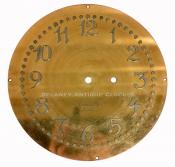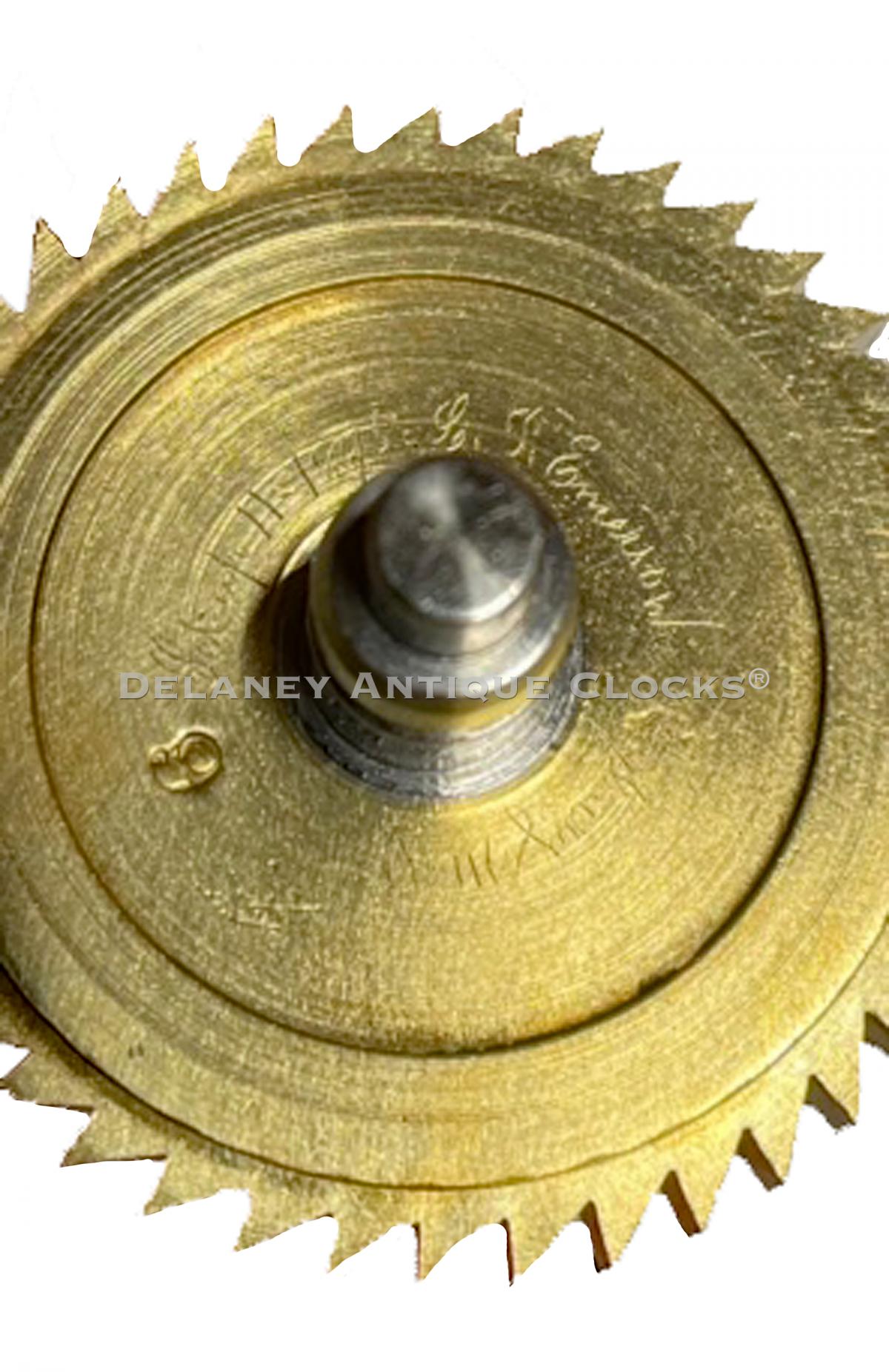E. Howard & Co Boston. This is a special-order Shelf Clock made for the Kistler house in Newton, MA. 223024.
This shelf clock was designed by the O.T. Smith Architectural firm of Boston, Massachusetts, specifically for Andrew and Ann Kislter's home located at 945 Beacon Street in Newton, Massachusetts. The order for manufacture was placed on October 7, 1895, out of Howard's Boston Office by O. T Smith Archit 23 _ St. Boston. The clock was to be shipped to A. M. (Reitter (crossd off )) Kistler / Beacon Street, Newton Center. The order in the Howard Shop Records specifies "1 Special Clock as per design, set arch on shelf. / case of oak but not to be finished. Dial 10.75 of brass / finished in gold color, Ara (Arabic) metal figures, dark oxidized / finish – Priced $125.00. /Promised in 3 weeks." It is interesting to note that a Howard Number 1 sold for $70, a Howard Number 6 was $100, and a Howard Number 36 was priced at $150.00. This pricing structure confirms that this custom-made example at $125 plus the additional cost of the architectural design was a very expensive clock in its day.
The Kistlers' house was built in 1893 and still stands today. It is considered by many as one of Newton Center's most elaborate Colonial Revival Homes. The two-and-a-half-story wood-framed house features a palladian window over the main entrance, leaded glass windows, various decorative moldings, and a full two-sided veranda. Andrew Kistler was a very successful leather dealer who worked in Boston. The Kistler family operated one of the largest and oldest sole leather and belting butts tanning businesses in the USA. They owned and operated tanneries in several locations, including Massachusetts, Pennsylvania, North Carolina, Missouri, Illinois, Mexico City, Mexico, and Buenos Aires, Brazil.
This shelf clock was designed to be secured to the top of a built-in cabinet. The case is oak and is finished with a darker stain. Four free-standing columns are fitted to the front of the case. These are fully turned and shaped. The upper two columns are decorated with floral carvings and Corinthian capitals. The bottom columns frame the lower section, which features an oval-shaped access panel. The panel is trimmed with an egg-and-dart carved molding. This door is hinged from the top and can be locked and closed with a key. Once open, one can access the pendulum bob. Two columns also frame the middle section of the case. The circular wooden bezel, carved with an additional egg-and-dart detail, is fitted with glass that protects the dial. Carved fans are located in each of the four corners of this middle panel. A woman's facial portrait is carved in the lunette. She is featured with her hair flowing away from the sides of her face as if being blown by the wind. This carving fills the lunette section. The molded arch is fitted with a key. The top of the arch is fitted with carved hippocampus figures. Hippocampus figures are depicted as a sea horse with the head and neck of a horse and the tail of a fish. They are finished in gilt and center the ancient Greek symbol for Hermes, a winged wheel. The modern use of this symbol is to symbolize progress in the worlds of engineering and transportation. The backboard is pine and is secured to the clock with screws from the back. Inside, it die-stamped with the date 11*1895.
As stated in the Howard Records, this is a special dial. It is brass and measures 11.25 inches in diameter. The dotted minute ring and the Arabic hours were applied to the gold surface. These details are raised off the plane of the dial. "E. Howard & Co. / Boston" is engraved in a script format above the hour VI. The hour and minute hands are fancifully designed.
The 8-day weight-driven movement is constructed in brass and is of very good quality. It is secured to the case with brass tabs. The Maker's name and working location are die-stamped onto the heavily cast front plate. This clock is powered by a lead weight (replaced) compounded to run for an eight-day run duration. This movement is also fitted with a Geneva stop-work winding mechanism. The great wheel is engraved, "Put up 11/95 L. P. Emmerson Roxbury." The pendulum rod is made of wood and is painted black. The bob is zinc and covered with a decorative brass cover. Regulation is performed by adjusting the threaded screw at the bottom of the bob. The pendulum is supported by a bridge secured to the front plate of the works.
This case has the following dimensions. It is 32.5 inches tall to the top of the carved wings. The upper molding is 19 inches wide and 8.5 inches deep.
This clock is inventory number 223024.
The E. Howard & Company succeeded the Howard & Davis firm in 1857. The Howard & Davis firm was comprised of Edward Howard and David Porter Davis and was established in 1842 in Roxbury, Massachusetts. Both men had just completed their clock apprenticeship under the guidance of Aaron Willard Jr in Boston. The Howard & Davis firm made high-grade clocks, precision balances, sewing machines, fire engines, and watches. After the dissolution of Howard & Davis, Edward Howard became Boston's leading manufacturer of weight-driven residential and commercial clocks. The firm also made a large number of tower clocks and watchman and salve clock systems. These sold well in the last quarter of the 1800s.
It has been said that the E. Howard Clock company never made an inexpensive clock, and everything they made was of very good quality. As a result, Howard clocks have become very collectible and are prized by their owners. Today, the E. Howard name enjoys outstanding name recognition.
For a more in-depth reading of Edward Howard and his various businesses, please read "Willard's Patent Time Pieces," written by Paul Foley.




















